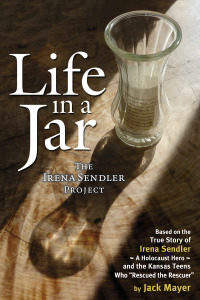Bridging the Gap Between Senior Citizens and Teenagers
What could two people from different sides of the world, different generations and different cultures possibly have in common? Teenager, Liz Cambers and senior citizen, Irena Sendler are two diametrically opposed individuals, in this true to life story, who transform each other and their terribly challenging life experiences into an amazing adventure of the meeting of two suffering souls. A reclusive elderly Polish lady and a rebellious teen form a deep and loving relationship in this fascinating book.
Liz Cambers grew up in a dysfunctional home with her Mom ultimately abandoning her when she is five years old. We meet Liz in September 1999, as an unhappy high school student in Uniontown High School situated in a small town in Kansas. Liz lived with her grandparents in the Kansas farming community of Mapletown. With an absentee father and deserter mother, Liz had all the makings of a troubled teen. Liz was a handful at home where she lived with her grandparents, as well as in school. She refused to do anything she did not agree on and often got into fights. When her Grandpa asked why she was so angry she always asked the same question, “Why did my mother leave me?”
Her disagreeable nature actually became her saving grace with her insistence that her social studies teacher be changed. When she came into class on the first day of school she was defiant. No way would she last again with the same teacher as last year who called her “a girl with a chip on her shoulder the size of Kansas”. By pleading with another social studies teacher, Mr. Conard, she was transferred to his class and the rest is history as we shall see.
Mr. Conard was the National History Day advisor whose class motto hung over the blackboard, “Who changes one person, changes the whole world,” (the Jewish Talmud). In order to stay in Mr. Conard’s class, Liz had to commit to a history day project, named Turning Points in History. Lackluster Liz met two other girls with their own sets of challenges and together they literally changed the world through their history day project.
 The project they chose was the amazing story of a little known, Christian Holocaust heroine, Irena Sendler who almost single handed saved over 2500 Jewish Children in Poland from extermination by the Nazis.
The project they chose was the amazing story of a little known, Christian Holocaust heroine, Irena Sendler who almost single handed saved over 2500 Jewish Children in Poland from extermination by the Nazis.
As the girls’ research began they found it difficult to find out much information about this mysterious, secret heroine, with her only son dead and Poland recovering from the second world war, Communist Poland was not the place to publicize any war time efforts. Irena Sendler settled into oblivion where even her neighbors in Poland had no idea of the heroine that was living right near them.
There was one idea that stood out above all the other information that was very slowly being accumulated by the girls who were working on the Irena Sendler Project. Irena Sendler had to convince the Jewish mothers of the Warsaw Ghetto to give up their children in order to save them. For Liz this was especially meaningful and painful. She realized that these mothers were giving up their children with a good chance that they would never see them again. How could they do it? Was it cruel or was it righteous? Irene found each child a home to stay with a righteous gentile family who risked their lives to save these children. If they were caught they would be murdered just as the very parents of these unfortunate children. For the first time in her life Liz realized that perhaps her mother acted righteously as well by giving up the child she loved so that Liz could have a better life. Could it be possible that after all the years of negativity and resentment, Liz could actually find admiration for a mother who gave up her child the same way Irena Sendler’s children were given up by their parents? Liz did hear snippets of family conversation regarding Her Mom, words like drugs, alcohol and prostitution. However, she could never justify that her mother would abandon a daughter. Now she was beginning to painfully realize that sometimes that could be the best thing a mom could do for their child.
By the time the girls working on the Irena Sendler Project met their heroine she was in her nineties. The relationship that they forged, teenagers and a senior citizen – is a model for all teenagers and senior citizens for all time. The girls began a wonderful correspondence through interpreters with their heroine and ultimately through a sponsor traveled to Poland to meet her. The relationship that they fostered with her, especially Liz, was so close and intimate that they were able to face struggles and challenges as they grew into more mature adults. She treated them with respect asking them if they had more questions. Of course, their ultimate question was why she did it, why did she risk her life so many times? They learned that even a regular person like them could change the world and after reading this book you will certainly see how powerful their project became worldwide.
For those fortunate enough to be close to grandparents the answer is evident as to why the generational difference between seniors and teens is a perfect format for the teen and senior to thrive.

Emotional Benefits of Children Having a Relationship With a Senior
At Hebrew University of Jerusalem, researchers surveyed over fourteen hundred preteen and teenagers from ages 12 to 18. They discovered that those with close relationships with seniors had less emotional issues and better social skills as well as less tendency towards violence.
There is a series on PBS called, In The Mix which explores learning experiences of teens and seniors. The series creates activities where seniors and teens interact and encourages better communication between the generations. One segment delved into the preconceived notions of what both seniors and teens thought of one another. In one segment, the program moderator brought the teens and seniors together to work on the teen’s favorite subject, technology.
Another segment asked the teens what kind of stereotype they had about seniors and vice versa. Each generation learned that their stereotyping was not accurate. Seniors said teens don’t listen and want instant gratification and teens judged the seniors by their disabilities and learned that they could still be smart and creative.
In the past, grandparents and grandchildren more often than not lived in close proximity to each other or reside in a nearby assisted living facility. This nearness encouraged close relationships between the two. If the teenager was having a difficult day at home he or she could hop over to the grandparents for tea and sympathy.
Today many grandparents are living longer and independently but tend to be far away from their grandchildren. Only one in eight single elderly adults lives with extended family. So even though children are more likely to have healthy active grandparents, they are seeing them less.
How to get seniors and teenagers together?
Programs for teens and seniors are increasing around the country. These programs provide a place for senior citizens and teenagers to meet and share their talents and have fun. At the Clinton Street Senior Center, teenagers from Pleasantville High School worked together for months to create a mosaic table for the garden and a beautiful mural for the wall. In New York City, women from University Settlement House work with at risk teens from, “The Door”. They develop and perform their own original scripts and both the teens and seniors perform together in an original off- Broadway show displaying their unique talents.
Bridging the gap between senior citizens and teens is not difficult. The first thing is for the teenager to see the human and youthful side of the senior. It could be through the senior’s historical stories or through his or her talents. Whichever way both the teens and seniors will surely become more complete and compassionate human beings. People who care change the world.
